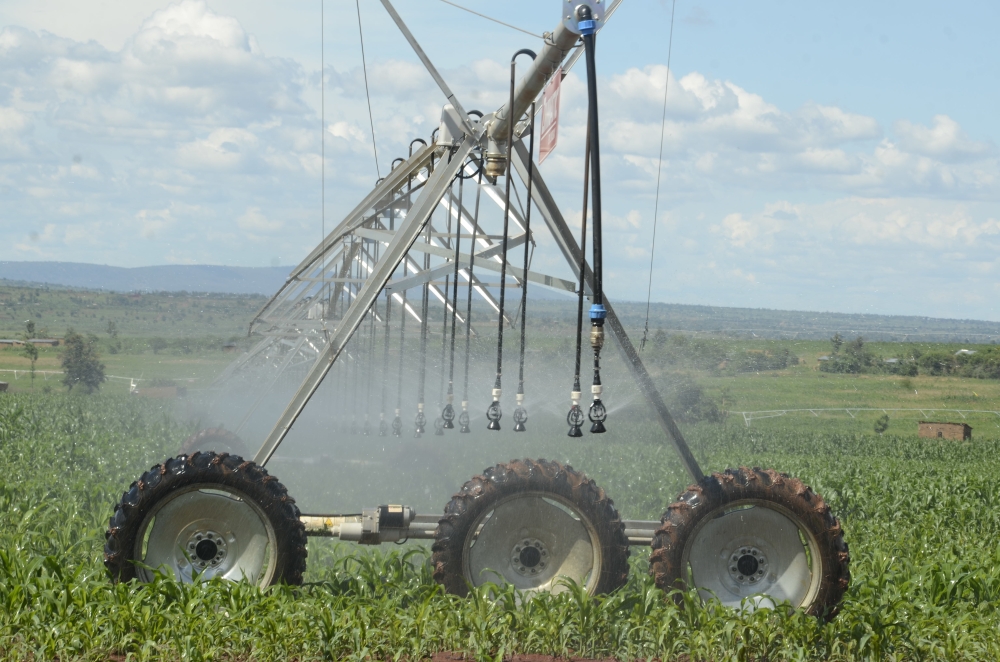

Rwanda is set to increase the area irrigated by solar power from the current 646 hectares to 1,146 hectares by 2029 under the Second National Strategy for Transformation (NST2), according to Rwanda Agriculture and Animal Resources Development Board (RAB).
ALSO READ: Will new solar powered irrigation scheme end farmers' woes?
Jerome Hitayezu, the head of the Department of Land Husbandry, Irrigation Innovation, and Technology Transfer at RAB, told The New Times that under NST2, "we aim to add 500 hectares of solar-powered irrigation by 2029. The yearly targets include 60 hectares by 2024-2025, 100 hectares each in 2025-2026 and 2026-2027, and 120 hectares each in 2027-2028 and 2028-2029.”
"Currently, 646 hectares of farmland are irrigated using solar power, and we plan to significantly expand this coverage in the coming years. The expansion is part of a broader effort to promote sustainable agriculture and reduce reliance on fossil fuels,” he added.
ALSO READ: Rural women make use of solar-powered irrigation under UN agencies support
Hitayezu explained how solar-powered irrigation provides sustainable solutions.
"When solar and diesel or petrol-based irrigation systems are compared, it can be seen that while the initial cost of diesel-based irrigation systems is lower, the operating costs of solar systems are substantially lower than those of other energy sources, such as diesel pumping systems, which are usually used in irrigation because most irrigated regions are located far from the grid. Solar energy also has a positive impact on the environment and helps to lower [green] gas emissions.”
Nationwide mobilization will also encourage farmers and private sector actors to implement solar irrigation systems independently, thereby expanding coverage beyond the areas subsidized by the government, he said.
"This expansion is designed to complement the government's efforts to offer subsidies for solar-powered irrigation systems,” he added.
The entire country is suitable, he said, for solar-powered irrigation, most specifically the eastern, southern and western-southern parts of the country.
Farmers like Marie Murekatete from Ndego Sector in Kayonza District, who have already adopted solar irrigation are seeing remarkable improvements in their yields.
Murekatete said that switching to solar irrigation transformed her farming operations.
"Before using solar irrigation, I could only harvest one tonne of grass per hectare. After two seasons with solar irrigation, my yield tripled to three tonnes per hectare,” she said.
"This irrigation system is environmentally friendly and eliminates the need for diesel or petroleum. I urge other farmers to consider switching, as we continue getting enough harvest even in the summer when others are no longer cultivating.”
Murekatete has used solar irrigation since 2020 and, despite the high cost, found it a worthwhile investment. "The system cost me Rwf64 million, and it helps me to irrigate five hectares. The only challenge is managing the labor required as I currently employ four workers to assist with irrigation."
According to Hitayezu, the cost of solar-powered irrigation systems varies depending on the specific design and the area of land being irrigated. However, the benefits such as lower operating costs, reduced negative environmental impact, and increased yields, he noted, make it an attractive option for farmers.
ALSO READ: Rwanda: Phasing out fossil fuel in irrigation amid COP28 climate talks
Hitayezu noted, "We are currently conducting assessments to identify systems that are still operational and those that need repair so that we can provide technical support.”
The districts currently covered by solar-powered irrigation systems across the country, are Bugesera with 236 hectares, Kayonza with 144 hectares, Rwamagana with 120 hectares, Nyagatare with 96 hectares, Ngoma with 40 hectares, and Ruhango with 10 hectares.


